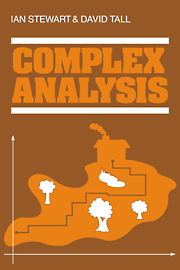Book contents
- Frontmatter
- Contents
- Preface
- Acknowledgement
- 0 The origins of complex analysis, and a modern viewpoint
- 1 Algebra of the complex plane
- 2 Topology of the complex plane
- 3 Power series
- 4 Differentiation
- 5 The exponential function
- 6 Integration
- 7 Angles, logarithms, and the winding number
- 8 Cauchy's Theorem
- 9 Homotopy versions of Cauchy's Theorem
- 10 Taylor series
- 11 Laurent series
- 12 Residues
- 13 Conformal transformations
- 14 Analytic continuation
- Index
7 - Angles, logarithms, and the winding number
Published online by Cambridge University Press: 05 June 2012
- Frontmatter
- Contents
- Preface
- Acknowledgement
- 0 The origins of complex analysis, and a modern viewpoint
- 1 Algebra of the complex plane
- 2 Topology of the complex plane
- 3 Power series
- 4 Differentiation
- 5 The exponential function
- 6 Integration
- 7 Angles, logarithms, and the winding number
- 8 Cauchy's Theorem
- 9 Homotopy versions of Cauchy's Theorem
- 10 Taylor series
- 11 Laurent series
- 12 Residues
- 13 Conformal transformations
- 14 Analytic continuation
- Index
Summary
If we attempt to define the logarithm of a complex number as some kind of ‘inverse’ to the exponential function, we have to face the fact that the latter is not a bijection, hence does not have an inverse in the technical sense. Unlike the real case, there is no very natural way to restrict its domain and codomain in such a way that it becomes a bijection – although a variety of more or less artificial such choices exist (such as the ‘cut plane’ ℂn below) and are indeed useful.
In classical terms, the logarithm has to be ‘multivalued’. The way in which its multiplicity of values fit together is closely analogous to the way that the measurement of an angle by radians gives not a single real number, but an infinite list differing only by multiples of 2π.
We shall discuss these ideas below, and apply them to a topological invariant known as the winding number of a curve relative to a point. In essence the total angle traversed by a point on the curve is measured as it moves continuously from one end to the other: if divided by 2π this gives the number of times that the curve winds around the point in question. This concept is extremely useful in the deeper parts of the subsequent theory.
Radian measure of angles
We first relate the ‘power series’ definition of sine to the usual geometric one, with the angle being measured in radians.
- Type
- Chapter
- Information
- Complex Analysis , pp. 120 - 140Publisher: Cambridge University PressPrint publication year: 1983



